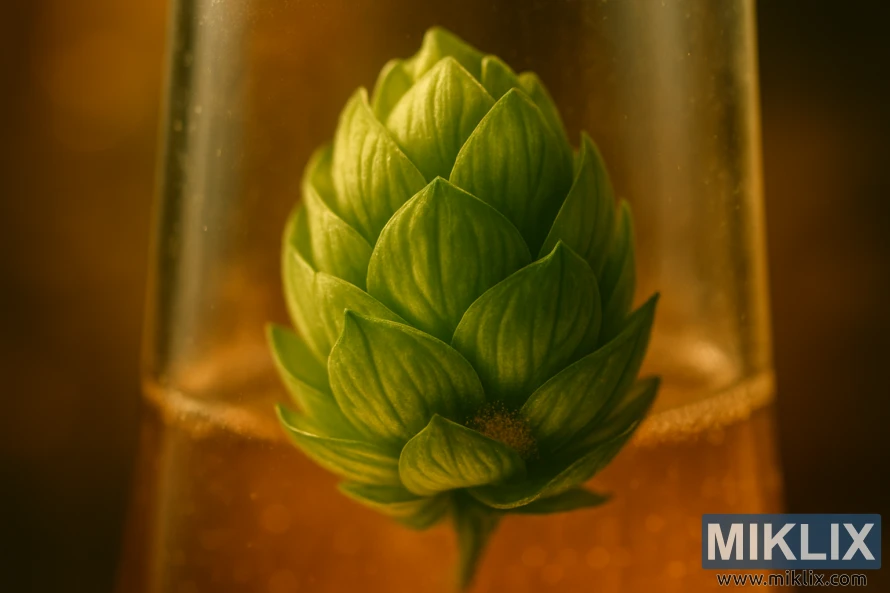Image: Golden Light on Hop Cone
Published: July 27, 2025 at 8:00:30 PM UTC
Last updated: September 27, 2025 at 12:05:19 PM UTC
A detailed close-up of a hop cone illuminated by golden light, showcasing its resinous glands and intricate layers, symbolizing flavor and aroma in brewing.
Suspended in a vessel of liquid gold, the hop cone becomes not merely an ingredient but a centerpiece, its vivid green form glowing against the warm amber backdrop. Each petal-like bract curves outward with sculptural precision, layered in a pattern that is both organic and geometric, resembling nature’s own meticulous design. The golden light that filters through the glass amplifies the vibrancy of its color, casting a subtle halo around the cone and emphasizing the intricate veins and textures that ripple across its surface. Tiny bubbles cling to the edges, rising in lazy trails that suggest both fermentation and effervescence, the living alchemy that transforms simple ingredients into a drink of extraordinary complexity.
This close-up captures the hop in a state of almost sacred suspension, as though caught between two worlds: one rooted in the earth and the fields where it grew, and the other immersed in the liquid that will carry its essence into the finished beer. The glass becomes both a container and a stage, its smooth walls amplifying the contrasts between sharp green and deep amber. Soft, hazy reflections in the vessel hint at a world just beyond focus, a reminder of the chemical processes at play and the nuanced balance of oils, acids, and resins that make hops indispensable to brewing.
What is most striking here is the sensory anticipation the image evokes. The hop’s appearance suggests aromas that hover at the edge of imagination: floral, citrusy, herbal, perhaps with a hint of spice or fruit, depending on the variety. Its glands, though invisible to the naked eye, seem almost palpable, bursting with lupulin, the powdery treasure that defines bitterness, flavor, and aroma. The lighting, rich and golden, amplifies this promise, making the cone seem to glow from within as though infused with the very essence of beer itself.
The photograph’s shallow depth of field heightens its intimacy, focusing all attention on the hop while allowing the background to melt into a soft haze of light and shadow. This choice draws the viewer into the cone’s layered form, compelling one to trace each curve and fold, to imagine the sticky texture under the fingertips, to smell the complex bouquet that would release if the bracts were gently pulled apart. The amber liquid in which it floats is more than a backdrop—it is a symbol of potential, of transformation, of the promise that this single cone, modest and compact, holds within it the power to shape the character of a beer.
There is a quiet reverence in the way the hop is presented, as if the image acknowledges not only its role in brewing but also its beauty as a natural object. It becomes both specimen and icon, inviting admiration not just for its function but for its form. The soft glow evokes associations of warmth, craftsmanship, and timeless rituals, suggesting the centuries of brewing tradition that have elevated the hop from a wild plant to a cultivated cornerstone of beer culture. At the same time, the clarity of the presentation speaks to modern craft brewing’s obsession with detail, chemistry, and sensory precision.
Ultimately, this composition is more than a still life. It is a meditation on the essence of brewing itself—a process in which something as humble as a green cone is steeped, transformed, and reimagined, yielding flavors that range from subtle whispers of earth and spice to bold declarations of fruit and resin. The hop, suspended in its amber stage, is not just a raw ingredient but a living metaphor for the artistry of beer: natural, scientific, beautiful, and endlessly capable of creating experiences that delight and surprise.
The image is related to: Hops in Beer Brewing: Target

